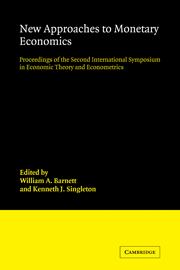 New Approaches to Monetary Economics
New Approaches to Monetary Economics Book contents
- Frontmatter
- Contents
- Editors' introduction
- List of contributors
- Part I Transactions motivated monetary holdings in general equilibrium
- Part II Financial intermediation
- Part III Monetary aggregation theory
- 6 The microeconomic theory of monetary aggregation
- 7 Monetary asset separability tests
- 8 Money demand in open economies: a Divisia application to the U.S. case
- 9 Aggregation of monetary goods: a production model
- 10 Money in the utility function: an empirical implementation
- 11 Comment on papers in Part III
- Part IV Issues on aggregate fluctuations
- Part V Theoretical issues in the foundations of monetary economics and macroeconomics
11 - Comment on papers in Part III
Published online by Cambridge University Press: 04 August 2010
- Frontmatter
- Contents
- Editors' introduction
- List of contributors
- Part I Transactions motivated monetary holdings in general equilibrium
- Part II Financial intermediation
- Part III Monetary aggregation theory
- 6 The microeconomic theory of monetary aggregation
- 7 Monetary asset separability tests
- 8 Money demand in open economies: a Divisia application to the U.S. case
- 9 Aggregation of monetary goods: a production model
- 10 Money in the utility function: an empirical implementation
- 11 Comment on papers in Part III
- Part IV Issues on aggregate fluctuations
- Part V Theoretical issues in the foundations of monetary economics and macroeconomics
Summary
Barnett's paper
In Part III of this volume, Barnett's paper (Chapter 6) brings together all of the currently available aggregation and index number theory relevant to monetary aggregation under perfect certainty. That theory includes demand side aggregation theory – which deals with aggregation over monetary assets when the aggregator functions are weakly separable input blocks in production functions or in utility functions – and supply side aggregation theory, which deals with aggregation over monetary assets when the aggregator functions are weakly separable output blocks in the transformation functions of multiproduct financial intermediaries. The theory also deals with aggregation over firms and consumers, technical change, and value added in financial intermediation. However, when uncertainty exists, the theory presented in Barnett's paper assumes risk neutrality. In that case all economic agents can be viewed as solving decision problems in a perfect-certainty form, with all random variables replaced by their expectations. In other words, a form of certainty equivalence is assumed.
Poterba and Rotemberg's paper
The risk neutrality assumption produces tremendous simplification and provides access to all of the existing literature on aggregation and index number theory. Nevertheless, if firms and consumers are very risk-averse, a more general approach to modeling uncertainty could be preferable. The Poterba and Rotemberg paper (Chapter 10) seeks to tackle that difficult problem through the use of the expected utility approach to modeling decisions under uncertainty.
- Type
- Chapter
- Information
- New Approaches to Monetary EconomicsProceedings of the Second International Symposium in Economic Theory and Econometrics, pp. 241 - 246Publisher: Cambridge University PressPrint publication year: 1987
